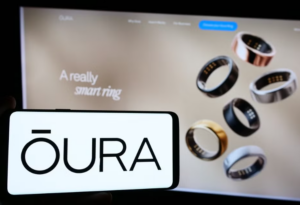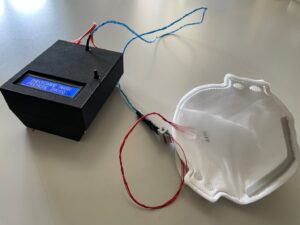In this week’s issue of The Savvy Diabetic:
- Axiom-4 Space Mission/Insulin in Space
- Omnipod ‘Pod Take Back Pilot’
- Oura/Dexcom Stelo App
- Urine Caffeine & Diabetic Retinopathy Risk in Men
- Specialized Face Mask Detects Kidney Disease
- Erythritol May Harm Brain & Heart
- Study Evaluates Medical Advice from AI Chatbots
- Interchangeable Status Boosts Scripts for Insulin Biosimilars
- Diabetic Supplies Gray Market
- Vaccination Site Matters for Immune Response
pump and insulin in the space was shared by Dr. Viral Shah on LinkedIn, 7 May 2024.
 4 Astronauts will take part in the Axiom 4 mission and will carry out ~60 scientific experiments. One of the experiments is called SuiteRide, which is going to explore blood glucose testing, data transmission, and insulin viability on ISS. Per their research, an insulin pump is working okay in microgravity experiments. “I do not know much about how they are going to conduct these experiments, but it sounds exciting and will open an opportunity for people with T1D and insulin-treated T2D for future space missions, said Dr. Shah.
4 Astronauts will take part in the Axiom 4 mission and will carry out ~60 scientific experiments. One of the experiments is called SuiteRide, which is going to explore blood glucose testing, data transmission, and insulin viability on ISS. Per their research, an insulin pump is working okay in microgravity experiments. “I do not know much about how they are going to conduct these experiments, but it sounds exciting and will open an opportunity for people with T1D and insulin-treated T2D for future space missions, said Dr. Shah.
-
-
- LAUNCH: May 29, 2025 1:03 PM
- DURATION: Up to 14 days docked to the ISS
- The Astronauts: Peggy Whitson – Commander
; Shubhanshu Shukla – Pilot,
; Sławosz Uznański-Wiśniewski – Mission Specialist,
; Tibor Kapu – Mission Specialist,
-
The mission emphasizes scientific portfolios led by the U.S., India, Poland (in partnership with ESA), and Hungary. It aims to boost participation in these countries by involving diverse stakeholders, showcasing the value of microgravity research, and fostering international collaboration. The studies will enhance global knowledge in human research, Earth observation, and life, biological, and material sciences, demonstrating the space research capabilities of the crew’s home nations.
Read more: Axiom Space
Together, we can build a more sustainable future from Insulet Corporation, makers of Omnipod!
 We are on a mission to simplify life for people with diabetes and create a more sustainable future. We are proud to offer you a pilot take-back program for our Pods.
We are on a mission to simplify life for people with diabetes and create a more sustainable future. We are proud to offer you a pilot take-back program for our Pods.
*The program is currently only available to customers who reside in Massachusetts or California.
Recycling your Pods is easy.
-
-
-
- Visit our website to fill out a form and receive a take-back kit. CLICK HERE: Pod Take Back Pilot
- Put your used Pods in the provided take-back kit and drop it off at any Fedex location. We will recycle the returned Pods.
- To return additional Pods, simply submit another request using the form below.
-
-
Questions? Call Omnipod Customer Care (24/7): 1-800-591-3455
ŌURA rolls out glucose app linked with Dexcom’s CGM Stelo published on GlobalData.com, 7 May 2025.
 ŌURA has signalled an entry into the consumer diabetes space, offering a new glucose feature for its ring that uses insights from Dexcom’s over-the-counter (OTC) continuous glucose monitor (CGM) Stelo.The integration between the Oura smart ring and Stelo is the culmination of a partnership between ŌURA and Dexcom in November 2024. The diabetes device giant invested $75m into Finland-based ŌURA to enable data flow between their respective products.
ŌURA has signalled an entry into the consumer diabetes space, offering a new glucose feature for its ring that uses insights from Dexcom’s over-the-counter (OTC) continuous glucose monitor (CGM) Stelo.The integration between the Oura smart ring and Stelo is the culmination of a partnership between ŌURA and Dexcom in November 2024. The diabetes device giant invested $75m into Finland-based ŌURA to enable data flow between their respective products.
The Glucose feature on the Oura app will show daily glucose readings set against periods of meals, sleep, stress, and activity. Data will be extracted from Stelo, the first biosensor approved by the US Food and Drug Administration (FDA) for use without a prescription. Oura will also provide insights to users on how glucose interacts with meals, stress, and daily movement. This, the ring developer says, will help patients learn lifestyle habits that help them maintain or achieve optimal glucose levels. The glucose feature was launched alongside Meals, an AI-powered tool that provides nutrition information from photographs of food.
Read more: ŌURA rolls out glucose app linked with Dexcom’s CGM Stelo
How urine caffeine levels may help detect diabetic eye damage early by Hugo Francisco de Souza for News-Medical.net, 7 May 2025.
 A new study reveals that certain caffeine metabolites in urine are linked to diabetic retinopathy risk in men, offering a promising path toward noninvasive biomarkers for early screening and disease prevention.
A new study reveals that certain caffeine metabolites in urine are linked to diabetic retinopathy risk in men, offering a promising path toward noninvasive biomarkers for early screening and disease prevention.
In a recent study in the journal Scientific Reports, researchers investigated the associations between urinary caffeine, its metabolites, and diabetic retinopathy (DR) risk in United States participants. In the cross-sectional study, high-performance liquid chromatography–electrospray ionization–tandem quadrupole mass spectrometry assays revealed that excessive urinary levels of 1-MU, 1,7-DMU, 1,3,7-TMU, caffeine, and AAMU may indicate increased DR risk in US males. Future prospective studies are needed to validate these findings, but they may represent a crucial step in understanding diabetic indicators.
Read more: How urine caffeine levels may help detect diabetic eye damage early
Specialized face mask can detect kidney disease with just your breath by the American Chemical Society and published on MedicalXpress.com, 7 May 2025.
 A modified mask could also protect a wearer by detecting health conditions, including chronic kidney disease. Researchers reporting in ACS Sensors incorporated a specialized breath sensor within the fabric of a face mask to detect metabolites associated with the disease. In initial tests, the sensor correctly identified people with the condition most of the time.
A modified mask could also protect a wearer by detecting health conditions, including chronic kidney disease. Researchers reporting in ACS Sensors incorporated a specialized breath sensor within the fabric of a face mask to detect metabolites associated with the disease. In initial tests, the sensor correctly identified people with the condition most of the time.
Kidneys remove waste products made by the body’s metabolic processes. But in the case of chronic kidney disease (CKD), these organs have become damaged and lose function over time, which can have wide-ranging implications on a person’s health. Currently, medical professionals diagnose the condition by measuring metabolites in blood or urine, but low-cost, low-tech systems, like the ones made from specialized candies, could make the process easier.
Chemical breath sensors are another diagnostic tool currently being explored because people with CKD exhale elevated levels of ammonia, a chemical associated with the condition. However, ammonia is also associated with other health conditions. Corrado Di Natale and colleagues wanted to create a specific sensor that simultaneously detects ammonia and other CKD-related metabolites.
The team’s sensor correctly identified when a patient had CKD 84% of the time (true positive) and that a patient did not have CKD 88% of the time (true negative). In addition, the results suggest that the sensor data can be used to estimate the stage of CKD, which could be highly valuable in the diagnostic process. The researchers say that these findings present the potential for straightforward, noninvasive, and cost-effective monitoring of CKD patients.
Read more: Specialized face mask can detect kidney disease with just your breath
Popular sugar substitute may harm brain and heart health by the American Physiological Society and published by MedicalXpress.com, 28 April 2025.
 Erythritol, a commonly used sugar substitute often marketed as “healthy,” may impair blood vessel health by disrupting the brain’s ability to produce a critical compound, according to new research. Scientists will present their findings at the 2025 American Physiology Summit in Baltimore. The Summit is the flagship annual meeting of the American Physiological Society.
Erythritol, a commonly used sugar substitute often marketed as “healthy,” may impair blood vessel health by disrupting the brain’s ability to produce a critical compound, according to new research. Scientists will present their findings at the 2025 American Physiology Summit in Baltimore. The Summit is the flagship annual meeting of the American Physiological Society.
Erythritol is a low-calorie sugar substitute found in many sugar-free products, including energy drinks, snack foods, and protein bars. Like other sugar alcohols, erythritol is popular because it does not affect blood glucose and insulin levels as much as sugar. However, previous research links consumption of erythritol to a higher risk of adverse cardiac events, including stroke.
In a new study, researchers treated human cerebral microvascular endothelial cells—cells from the tiny blood vessels in the brain with erythritol. They found that the cells exposed to the amount of sweetener in one beverage serving had higher levels of oxidative (cellular) stress. In addition, the cells produced less nitric oxide, a compound that helps blood vessels dilate. Reduced nitric oxide levels can impair vasodilation, impair blood flow, and may increase the risk of heart attack and stroke. “While erythritol is widely used in sugar-free products marketed as healthier alternatives, more research is needed to fully understand its impact on vascular health,” said Auburn Berry, a graduate student at the University of Colorado Boulder and first author of the study.
Read more: Popular sugar substitute may harm brain and heart health
Chatbot accuracy: Study evaluates medical advice from AI chatbots and other sources by Bob Yirka for MedicalXpress.com, 9 May 2025.
 A team of AI and medical researchers, affiliated with several institutions in the U.K. and the U.S., has tested the accuracy of medical information and advice given by LLMs to users. In their paper posted on the arXiv preprint server, the group describes how they asked 1,298 volunteers to query chatbots for medical advice. They then compared the results to advice from other online sources or the user’s common sense.
A team of AI and medical researchers, affiliated with several institutions in the U.K. and the U.S., has tested the accuracy of medical information and advice given by LLMs to users. In their paper posted on the arXiv preprint server, the group describes how they asked 1,298 volunteers to query chatbots for medical advice. They then compared the results to advice from other online sources or the user’s common sense.
Prior research has shown that AI apps can achieve near-perfect scores on medical licensing exams and also perform very well on other medical benchmarks. However, little work has been done to see how well such abilities translate to the field. Prior research has also shown that it takes a lot of skill and experience for doctors to get their patients to ask better questions and/or to provide better answers to their queries.
When comparing possible causes of an ailment and treatment options suggested by the chatbots with other sources, such as other online medical sites, and even the volunteer’s own intuition, the researchers found the advice given by the chatbots to be similar in some circumstances and worse in others. Rarely did they find any evidence of the LLMs offering better advice.
They also found a lot of examples where the use of a chatbot made the volunteers less likely to identify their ailment correctly and to underestimate the severity of their problem. They conclude by suggesting people use a more trusted source of information when seeking medical advice.
Our experiences in the open source community: PLEASE DO NOT USE AI ChatBot to recommend and adjust your diabetes management therapy settings. They may seem “ok” but we’ve seen too many instances where the suggested dosing changes would cause harm or subject the diabetic to experience unexpected or serious low BGs. If you are curious, feel free to ask ChatBots for recommendations … THEN check with your healthcare provider before adopting the ChatBot recommendations!
Read more: Chatbot accuracy: Study evaluates medical advice from AI chatbots and other sources
Interchangeable Status Rapidly Boosted Scripts for Insulin Biosimilar by Kristen Monaco for MedPageToday.com, 2 May 2025.
 Prescriptions for insulin glargine-yfgn (Semglee) rapidly increased when its status switched from a standard biosimilar to the first interchangeable insulin biosimilar. After the biosimilar officially launched with its interchangeable status in November 2021 — allowing for pharmacy-level substitutions — there was a discontinuous increase of 47,410 dispensed prescriptions for the generic and brand name forms of the long-acting insulin biosimilar, reported Stephen Murphy, PhD, and Nicholas Holtkamp, PhD, both of HHS in Washington, D.C. he sharp increase suggests the “interchangeable designation was associated with substantially increased utilization,” the pair wrote in JAMA Health Forum. Increases were seen across retail, mail order, and long-term care pharmacy dispensing channels.
Prescriptions for insulin glargine-yfgn (Semglee) rapidly increased when its status switched from a standard biosimilar to the first interchangeable insulin biosimilar. After the biosimilar officially launched with its interchangeable status in November 2021 — allowing for pharmacy-level substitutions — there was a discontinuous increase of 47,410 dispensed prescriptions for the generic and brand name forms of the long-acting insulin biosimilar, reported Stephen Murphy, PhD, and Nicholas Holtkamp, PhD, both of HHS in Washington, D.C. he sharp increase suggests the “interchangeable designation was associated with substantially increased utilization,” the pair wrote in JAMA Health Forum. Increases were seen across retail, mail order, and long-term care pharmacy dispensing channels.
Read more: Interchangeable Status Rapidly Boosted Scripts for Insulin Biosimilar
The Diabetic Supplies Gray Market Is Ripe for Disruption by Jacob Murphy for MedPageToday.com, 4 May 2025.
“CA$H 4 SEALED & UNEXPIRED DIABETIC TEST STRIPS — CALL NOW.”
 This message, printed in black on a neon yellow poster board, hangs just outside the $1.1 billion Charlotte R. Bloomberg Children’s Center at Johns Hopkins Hospital. The sign represents a peculiar offshoot of American healthcare: the diabetic supplies gray market. Here, blood glucose test strips are exchanged within an informal network.
This message, printed in black on a neon yellow poster board, hangs just outside the $1.1 billion Charlotte R. Bloomberg Children’s Center at Johns Hopkins Hospital. The sign represents a peculiar offshoot of American healthcare: the diabetic supplies gray market. Here, blood glucose test strips are exchanged within an informal network.
This market operates through handwritten signs and websites like QuickCash4TestStrips.com, often flourishing in areas with high rates of poverty and uninsured patients. How does it work? Insured patients obtain excess test strips at little personal cost through insurance, then sell them to reseller companies. These companies profit by selling the strips below original retail prices, which far exceed manufacturing costs, to uninsured individuals. And, surprisingly, this is all legal. As one company owner candidly admitted, “I’m taking advantage, as are my peers, of a loophole.”
So, does this unregulated market provide a valuable lifeline or a dangerous compromise? And do academic medical centers have an obligation to intervene in these exchanges thriving in their backyards?
Read more: The Diabetic Supplies Gray Market Is Ripe for Disruption
Off Topic but May Be Applicable: Left or right arm? New research reveals why vaccination site matters for immune response by Garvan Institute of Medical Research and published on MedicalXpress.com, 28 April 2025.
 Sydney scientists have revealed why receiving a booster vaccine in the same arm as your first dose can generate a more effective immune response more quickly. The study, led by the Garvan Institute of Medical Research and the Kirby Institute at UNSW Sydney and published in the journal Cell, offers new insight that could help improve future vaccination strategies.
Sydney scientists have revealed why receiving a booster vaccine in the same arm as your first dose can generate a more effective immune response more quickly. The study, led by the Garvan Institute of Medical Research and the Kirby Institute at UNSW Sydney and published in the journal Cell, offers new insight that could help improve future vaccination strategies.
The researchers found that specialized immune cells called macrophages become “primed” inside lymph nodes when a vaccine is administered. These macrophages then direct the positioning of memory B cells to more effectively respond to the booster when given in the same arm. The findings, made in mice and validated in human participants, provide evidence to refine vaccination approaches and offer a promising new approach for enhancing vaccine effectiveness. “This is a fundamental discovery in how the immune system organizes itself to respond better to external threats—nature has come up with this brilliant system and we’re just now beginning to understand it,” says Professor Tri Phan, Director of the Precision Immunology Program at Garvan and co-senior author.
Immunization introduces a harmless version of a pathogen, known as a vaccine antigen, into the body, which is filtered through lymph nodes—immune ‘training camps’ that train the body to fight off the real pathogen. The researchers previously discovered that memory B cells, which are crucial for generating antibody responses when infections return, linger in the lymph node closest to the injection site.
Using state-of-the-art intravital imaging at Garvan, the team discovered that memory B cells migrate to the outer layer of the local lymph node, where they interact closely with the macrophages that reside there. When a booster was given in the same location, these ‘primed’ macrophages—already on alert—efficiently captured the antigen and activated the memory B cells to make high-quality antibodies.
Read more: Left or right arm? New research reveals why vaccination site matters for immune response

